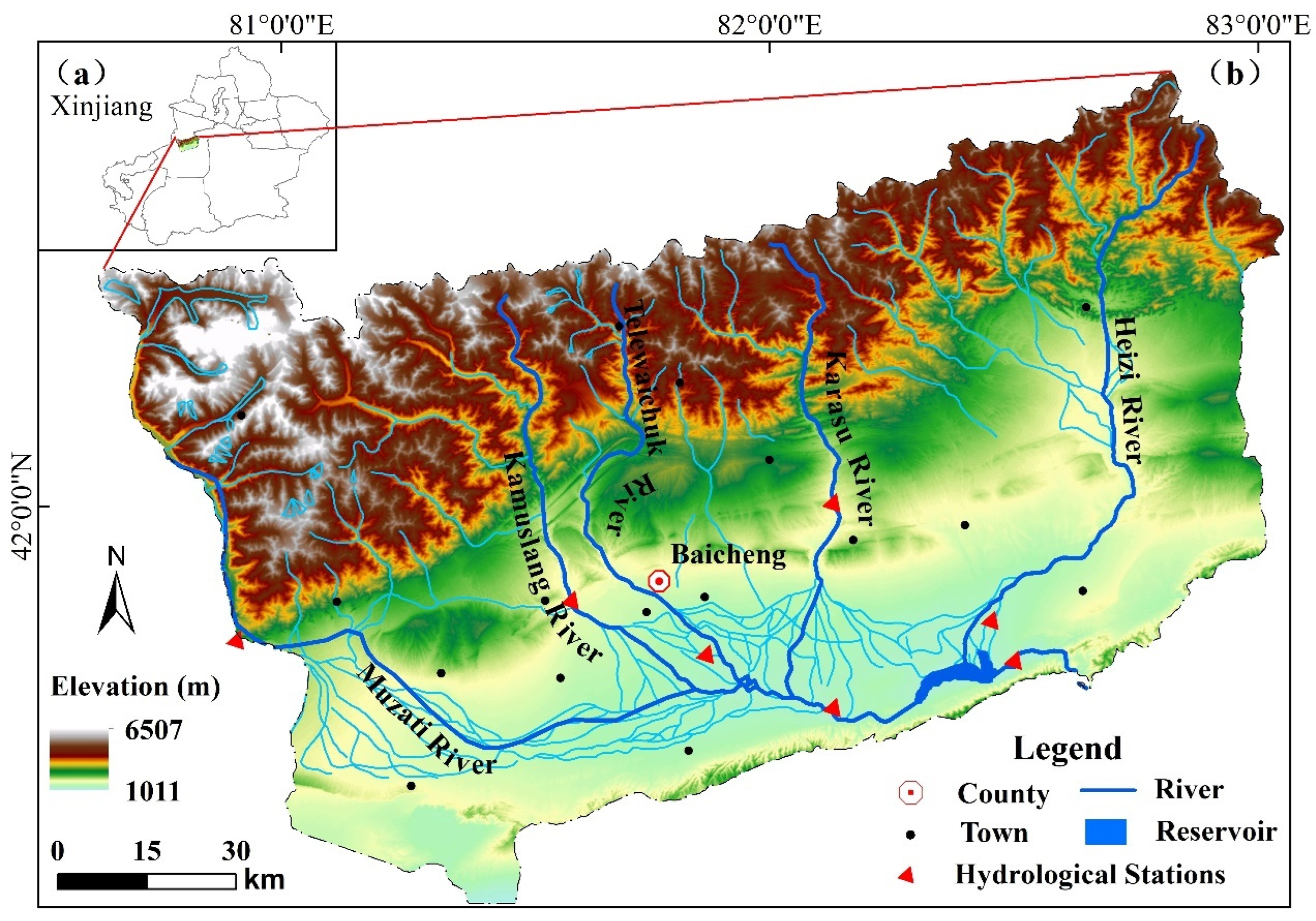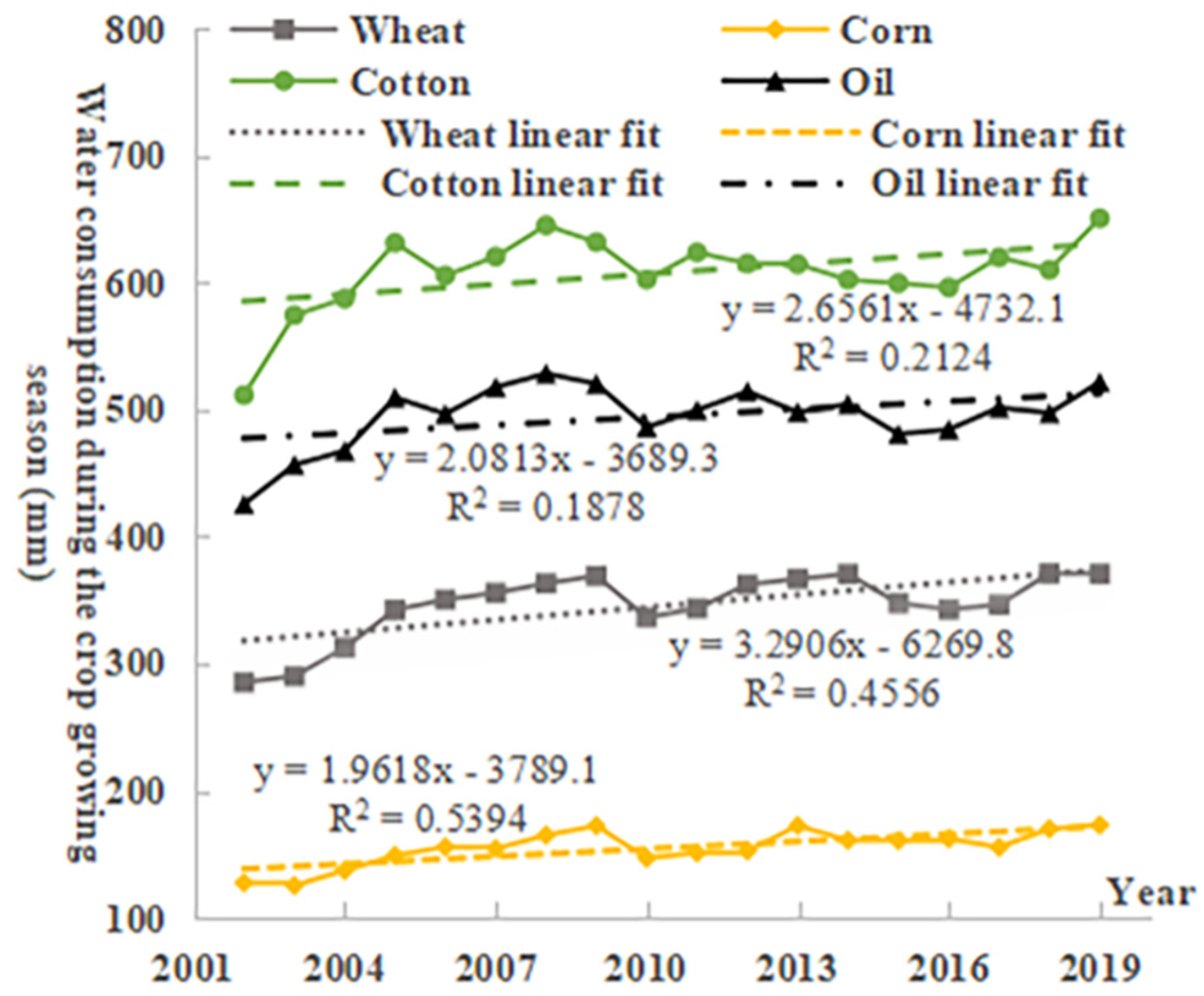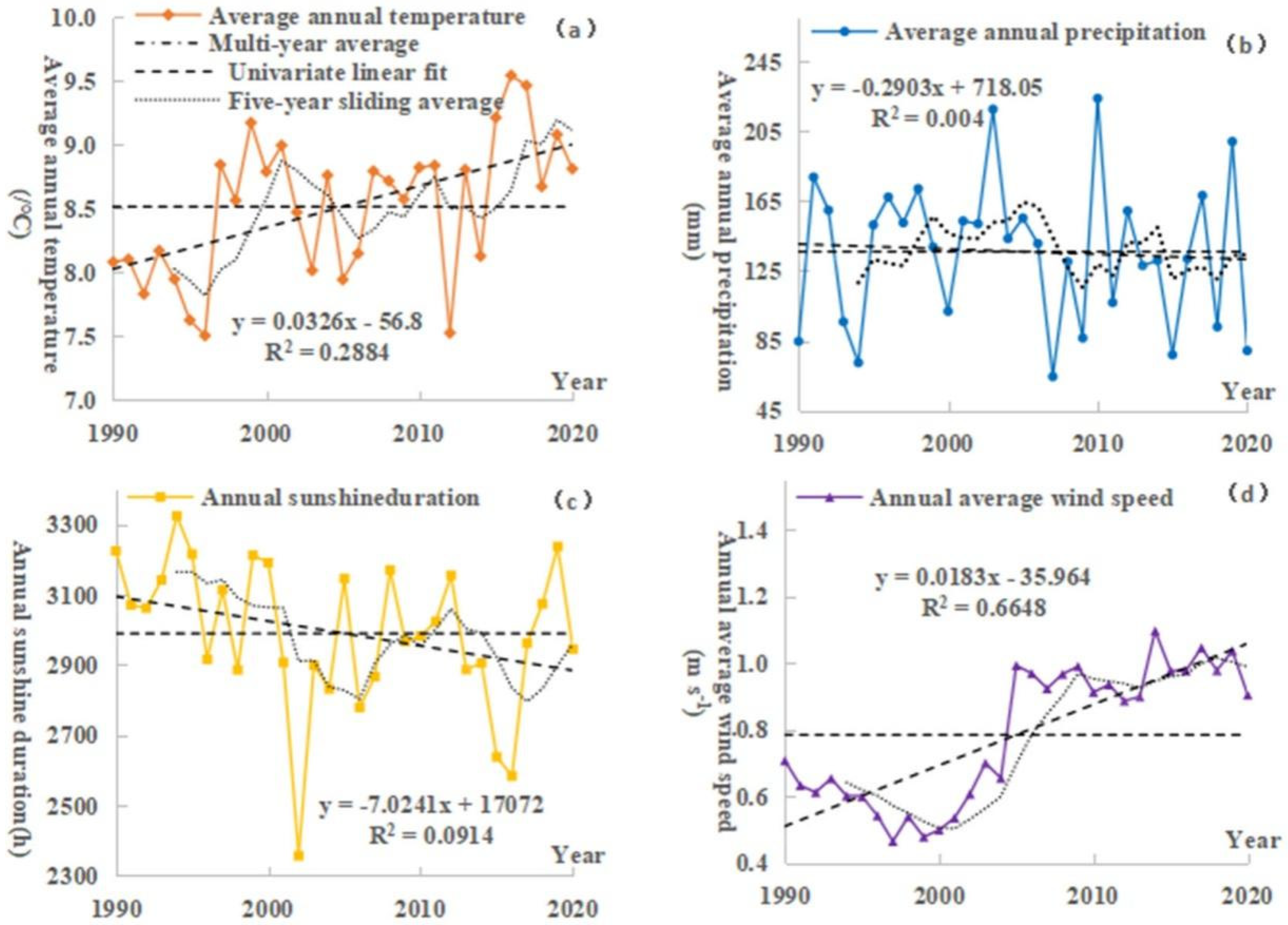Effects of Climate and Land Use Change on Agricultural Water Consumption in Baicheng County
Abstract
1. Introduction
2. Materials and Methods
2.1. Study Area
2.2. Data Sources
2.3. Methods
2.3.1. Evapotranspiration of Crops
2.3.2. Linear Trend Estimation Method
2.3.3. Land Use Transfer Matrix
2.3.4. Sensitivity Analysis
3. Results and Discussion
3.1. Characteristics of Changes in Agricultural Water Consumption
3.2. The Driving Factors of the Changing Characteristics of Agricultural Water Consumption
3.2.1. Climate Change Characteristics
3.2.2. Land Use Type Change Characteristics
3.3. Influencing Factors of Agricultural Water Consumption in the Oasis
3.3.1. Impact of Climate Change on Water Consumption in Agriculture
3.3.2. Impact of Land Use Change on Water Consumption in Agriculture
4. Conclusions
- (1)
- From 2002 to 2019, the water consumption of the main crops during the growth period from high to low was cotton (512–645 mm), oil (426–529 mm), wheat (285–369 mm), and corn (125–173 mm). The total green water consumption of the Baicheng County oasis showed an increasing trend. This was caused by climate change and changes in agricultural planting structure.
- (2)
- The sensitivity of AWC to meteorological factors was as follows: mean temperature (1.56) > mean wind speed (0.6) > precipitation (−0.12) > sunshine duration (−0.06). Temperature and wind speed were the dominant factors that increased the evapotranspiration of oasis crops, resulting in an increasing trend of agricultural water consumption in the study area.
- (3)
- The overall cultivated land area in the Baicheng County oasis increased from 1024.37 km2 in 1990 to 1273.50 km2 in 2020, an increase of 24.32%. Agricultural irrigation in the study area mainly depended on surface water, and the increase in cultivated land area directly led to the increase in agricultural water consumption. The increase in cultivated land area was the main reason for the increase in agricultural water consumption in the study area.
Author Contributions
Funding
Institutional Review Board Statement
Informed Consent Statement
Data Availability Statement
Conflicts of Interest
References
- Falkenmark, M. The New Blue and Green Water Paradigm: Breaking New Ground for Water Resources Planning and Management. J. Water Resour. 2006, 132, 129–132. [Google Scholar] [CrossRef]
- Xie, Z.; Zhu, K.; Lu, F.; Xu, Y.; Song, X. Trend analysis for blue and green water resources in Chaobai river basin based on hydrologic cycle simulation. J. China Hydrol. 2019, 39, 32, 44–49. [Google Scholar]
- Nan, J.; Wang, Y.; Shang, H.; Zhao, X.; Wu, P.; Ma, X.; Xiao, J. Investigation and developing count measures on current water using situation for agriculture in Heihe River Basin. China Rural Water Hydrol. 2010, 7, 37–40. [Google Scholar]
- Gao, X.; Cheng, W.; Wang, N.; Liu, Q.; Ma, T.; Chen, Y.; Zhou, C. Spatio-temporal distribution and transformation of cropland in geomorphologic regions of China during 1990–2015. J. Geogr. Sci. 2019, 29, 180–196. [Google Scholar] [CrossRef]
- Yang, L.; Feng, Q.; Yin, Z.; Wen, X.; Si, J.; Li, C.; Deo, R.C. Identifying separate impacts of climate and land use/cover change on hydrological processes in upper stream of Heihe River, Northwest China. Hydrol. Process. 2017, 31, 1100–1112. [Google Scholar] [CrossRef]
- Nian, Y.; Li, X.; Zhou, J.; Hu, X. Impact of land use change on water resource allocation in the middle reaches of the Heihe River Basin in northwestern China. J. Arid Land 2014, 6, 273–286. [Google Scholar] [CrossRef]
- Borrelli, P.; Robinson, D.A.; Panagos, P.; Lugato, E.; Yang, J.E.; Alewell, C.; Wuepper, D.; Montanarella, L.; Ballabio, C. Land use and climate change impacts on global soil erosion by water (2015–2070). Proc. Natl. Acad. Sci. USA 2020, 117, 21994–22001. [Google Scholar] [CrossRef]
- IPCC. Climate Change 2022: Impacts, Adaptation and Vulnerability [M/OL]. 2022. Available online: https://www.ipcc.ch/report/sixth-assessment-report-working-group-ii/ (accessed on 27 February 2022).
- Tao, F.; Yokozawa, M.; Liu, J.; Zhang, Z. Climate–crop yield relationships at provincial scales in China and the impacts of recent climate trends. Clim. Res. 2008, 38, 83–94. [Google Scholar] [CrossRef]
- Zhang, J. Action of National Water Conservation highlights impact of climate change. China Water Resour. 2018, 6, 11–13. [Google Scholar]
- Liu, C.; Zhang, D.; Liu, X.; Zhao, C. Spatial and temporal change in the potential evapotranspiration sensitivity to meteorological factors in China (1960−2007). J. Geogr. Sci. 2012, 22, 3–14. [Google Scholar] [CrossRef]
- Suat, I.; Isa, K.; Kari, E.S.; Denis, M. Trend and magnitude of changes in climate variables and reference evapotranspiration over116-yr period in the Platte River Basin, central Nebraska-USA. J. Hydrol. 2012, 420–421, 228–244. [Google Scholar]
- Mougou, R.; Mansour, M.; Iglesias, A.; Chebbi, R.Z.; Battaglini, A. Climate change and agricultural vulnerability: A case study of rain-fed wheat in Kairouan, Central Tunisia. Reg. Environ. Change 2010, 11, 137–142. [Google Scholar]
- Tong, L.; Kang, S.; Zhang, L. Temporal and spatial variations of evapotranspiration for spring wheat in the Shiyang river basin in northwest China. Agric. Water Manag. 2007, 87, 241–250. [Google Scholar] [CrossRef]
- Mahsa, M.; Ali, N.; Amir, S.d.; Malekian, A. Sustainable Water Supply and Demand Management in Semi-arid Regions: Optimizing Water Resources Allocation Based on RCPs Scenarios. Water Resour. Manag. 2021, 35, 5307–5324. [Google Scholar]
- Wu, P.; Jin, J.; Zhao, X. Impact of climate change and irrigation technology advancement on agricultural water use in China. Clim. Change 2010, 100, 797–805. [Google Scholar] [CrossRef]
- Lu, Y.; Cai, H.; Jiang, T.; Sun, S.; Wang, Y.; Zhao, J.; Yu, X.; Sun, J. Assessment of global drought propensity and its impacts on agricultural water use in future climate scenarios. Agric. For. Meteorol. 2019, 278, 107623. [Google Scholar] [CrossRef]
- Sun, S.; Zhou, T.; Wu, P.; Wang, Y.; Zhao, X.; Yin, Y. Impacts of future climate and agricultural land-use changes on regional agricultural water use in a large irrigation district of northwest China. Land Degrad. Dev. 2019, 30, 1158–1171. [Google Scholar] [CrossRef]
- Lopes, T.R.; Zolin, C.A.; Mingoti, R.; Vendrusculo, L.G.; Almeida, F.T.d.; Souza, A.P.d.; Oliveira, R.F.d.; Paulino, J.; Uliana, E.M. Hydrological regime, water availability and land use/land cover change impact on the water balance in a large agriculture basin in the Southern Brazilian Amazon. J. S. Am. Earth Sci. 2021, 108, 103224. [Google Scholar] [CrossRef]
- Tang, Y.H.; Luan, X.B.; Sun, J.X.; Zhao, J.F.; Yin, Y.L.; Wang, Y.B.; Sun, S.K. Impact assessment of climate change and human activities on GHG emissions and agricultural water use. Agric. For. Meteorol. 2021, 296, 108218. [Google Scholar] [CrossRef]
- Lai, J.; Li, Y.; Chen, J.; Niu, G.-Y.; Lin, P.; Li, Q.; Wang, L.; Han, J.; Luo, Z.; Sun, Y. Massive crop expansion threatens agriculture and water sustainability in northwestern China. Environ. Res. Lett. 2022, 17, 034003. [Google Scholar] [CrossRef]
- Srivastav, A.L.; Dhyani, R.; Ranjan, M.; Madhav, S.; Sillanpaa, M. Climate-resilient strategies for sustainable management of water resources and agriculture. Environ. Sci. Pollut. Res. 2021, 28, 41576–41595. [Google Scholar] [CrossRef]
- Stefanidis, S. Ability of Different Spatial Resolution Regional Climate Model to Simulate Air Temperature in a Forest Ecosystem of Central Greece. J. Environ. Prot. Ecol. 2021, 22, 1488–1495. [Google Scholar]
- Meng, J.; Yao, X.; Yang, X.; Luo, J.; Shen, Y. Spatial and temporal evolution of agricultural planting structure and crop water consumption in groundwater overdraft area. Trans. CSAM 2020, 51, 302–312. [Google Scholar]
- Sun, S.K.; Wu, P.T.; Wang, Y.B.; Zhao, X.N. Impact of changing cropping pattern on the regional agricultural water productivity. J. Agric. Sci. 2014, 153, 767–778. [Google Scholar] [CrossRef]
- Du, M.; Li, L.; Luo, G.; Dong, K.; Shi, Q. Effects of climate and land use change on agricultural water consumption in Yutian Oasis. Bull. Soil Water Conserv. 2020, 40, 2, 103–109. [Google Scholar]
- Yang, F.; Wang, X. Impact of irrigation water price and technological progress on agricultural water intensity-an empirical study based on three major staple foods. Agric. Mod. Res. 2021, 42, 735–744. [Google Scholar]
- Castellini, M.; Di Prima, S.; Stewart, R.; Biddoccu, M.; Rahmati, M.; Alagna, V. Advances in Ecohydrology for Water Resources Optimization in Arid and Semi-Arid Areas. Water 2022, 14, 1830. [Google Scholar] [CrossRef]
- Ke, Y.; Sheng, Z.; Bai, J.; Li, J.; Chang, C.; Xu, Z. Suitable scale of arable land in the Weigan River Basin under the constraints of water resources. Arid Zone Res. 2020, 37, 551–561. [Google Scholar]
- Cheng, D.; Yang, D.; Tang, H.; Zhang, Y.; Xia, W. Agricultural water consumption intensity and effecting factors in Ogan River Basin. Arid Land Geogr. 2014, 37, 509–519. [Google Scholar]
- Allen, R.; Pereira, L.S.; Raes, D.; Smith, M. Crop evapotranspiration: Guidelines for computing crop water requirements. Food Agri. Org. United Nations Irrig. Drain 1998, 56, 300. [Google Scholar]
- Wu, S.; Zhao, W.; Yao, J.; Jin, J.; Zhang, M.; Jiang, G. Precipitation variations in the Tai Lake Basin from 1971 to 2018 based on innovative trend analysis. Ecol. Indic. 2022, 139, 108868. [Google Scholar] [CrossRef]
- Yang, W.; Jiang, X. Evaluating the influence of land use and land cover change on fine particulate matter. Sci. Rep. 2021, 11, 17612. [Google Scholar] [CrossRef]
- Zheng, H.; Zhang, L.; Zhu, R.; Liu, C.; Sato, Y.; Fukushima, Y. Responses of streamflow to climate and land surface change in the headwaters of the Yellow River Basin. Water Resour. Res. 2009, 45, 7. [Google Scholar] [CrossRef]
- Li, X. Key scientific issues for green water research in the watershed. Adv. Earth. Sci. 2008, 23, 707–712. [Google Scholar]






| Year | Annual Mean Temperature (°C) | Annual Precipitation (mm) | Annual Sunshine Duration (h) | Annual Mean Wind Speed (m s−1) |
|---|---|---|---|---|
| 1991–2000 | 8.26 | 138.99 | 3113 | 0.51 |
| 2001–2010 | 8.53 | 146.69 | 2890 | 0.77 |
| 2011–2020 | 8.81 | 127.30 | 2941 | 0.93 |
| Land Use Type | Area (km2) | Percentage (%) | Area of Change (km2) | ||||||||
|---|---|---|---|---|---|---|---|---|---|---|---|
| 1990 | 2000 | 2010 | 2020 | 1990 | 2000 | 2010 | 2020 | 1990–2000 | 2000–2010 | 2010–2020 | |
| Cultivated land | 1024.37 | 1068.64 | 1233.45 | 1273.50 | 6.45 | 6.73 | 7.77 | 8.03 | +44.27 | +164.81 | +40.05 |
| Forest land | 638.05 | 638.46 | 441.95 | 416.51 | 4.02 | 4.02 | 2.79 | 2.62 | +0.41 | −196.51 | -25.44 |
| Grassland | 6112.34 | 6073.63 | 6042.91 | 6057.79 | 38.51 | 38.26 | 38.08 | 38.18 | −38.71 | −30.72 | +14.88 |
| Water area | 1126.53 | 1135.16 | 758.00 | 732.95 | 7.10 | 7.15 | 4.78 | 4.62 | +8.63 | −377.16 | −25.05 |
| Urban and rural residential land | 43.24 | 47.55 | 74.1 | 111.95 | 0.27 | 0.30 | 0.47 | 0.71 | +4.31 | +26.55 | +37.85 |
| Unused land | 6926.53 | 6909.85 | 7316.96 | 7274.68 | 43.64 | 43.53 | 46.11 | 45.85 | −16.68 | +407.11 | −42.28 |
| Year | Land Use Type | Grassland | Urban and Rural Residential Land | Cultivated Land | Forest Land | Water Area | Unused Land |
|---|---|---|---|---|---|---|---|
| 1990–2000 | Grassland | 6021.79 | 0.47 | 29.77 | 0.19 | 2.13 | 19.48 |
| Urban and rural residential land | 0.65 | 39.02 | 6.35 | 0.00 | 0.00 | 1.53 | |
| Cultivated land | 63.64 | 3.67 | 977.64 | 0.01 | 2.15 | 21.55 | |
| Forest land | 0.33 | 0.00 | 0.17 | 637.84 | 0.00 | 0.11 | |
| Water area | 17.88 | 0.05 | 4.61 | 0.00 | 1107.57 | 5.28 | |
| Unused land | 8.05 | 0.02 | 5.83 | 0.00 | 14.78 | 6878.58 | |
| 2000–2010 | Grassland | 3936.95 | 2.32 | 56.22 | 395.61 | 52.27 | 1599.71 |
| Urban and rural residential land | 9.42 | 14.61 | 39.34 | 0.05 | 0.73 | 9.96 | |
| Cultivated land | 198.99 | 27.22 | 869.59 | 4.37 | 12.83 | 120.49 | |
| Forest land | 180.69 | 1.91 | 35.67 | 217.28 | 0.64 | 5.77 | |
| Water area | 124.90 | 0.88 | 23.81 | 4.2 | 493.83 | 110.91 | |
| Unused land | 1622.69 | 0.61 | 44.01 | 16.95 | 574.87 | 5060.01 | |
| 2010–2020 | Grassland | 5959.08 | 0.32 | 11.38 | 46.76 | 24.86 | 15.38 |
| Urban and rural residential land | 10.02 | 69.54 | 11.74 | 0.69 | 0.14 | 19.82 | |
| Cultivated land | 32.57 | 3.85 | 1199.09 | 2.12 | 2.73 | 33.14 | |
| Forest land | 21.75 | 0.12 | 2.26 | 392.15 | 0.13 | 0.10 | |
| Water area | 3.97 | 0.10 | 2.87 | 0.13 | 714.04 | 11.84 | |
| Unused land | 15.50 | 0.16 | 6.11 | 0.11 | 16.12 | 7236.68 |
| Climate Impact Factor | Annual Mean Temperature (°C) | Annual Precipitation (mm) | Annual Sunshine Duration (h) | Annual Mean Wind Speed (m s−1) |
|---|---|---|---|---|
| Sensitivity factor | 1.56 | −0.12 | −0.06 | 0.60 |
Publisher’s Note: MDPI stays neutral with regard to jurisdictional claims in published maps and institutional affiliations. |
© 2022 by the authors. Licensee MDPI, Basel, Switzerland. This article is an open access article distributed under the terms and conditions of the Creative Commons Attribution (CC BY) license (https://creativecommons.org/licenses/by/4.0/).
Share and Cite
Zhang, Q.; Yue, C.; Li, Y.; Hu, X. Effects of Climate and Land Use Change on Agricultural Water Consumption in Baicheng County. Sustainability 2022, 14, 13746. https://doi.org/10.3390/su142113746
Zhang Q, Yue C, Li Y, Hu X. Effects of Climate and Land Use Change on Agricultural Water Consumption in Baicheng County. Sustainability. 2022; 14(21):13746. https://doi.org/10.3390/su142113746
Chicago/Turabian StyleZhang, Qin, Chunfang Yue, Yizhen Li, and Xin Hu. 2022. "Effects of Climate and Land Use Change on Agricultural Water Consumption in Baicheng County" Sustainability 14, no. 21: 13746. https://doi.org/10.3390/su142113746
APA StyleZhang, Q., Yue, C., Li, Y., & Hu, X. (2022). Effects of Climate and Land Use Change on Agricultural Water Consumption in Baicheng County. Sustainability, 14(21), 13746. https://doi.org/10.3390/su142113746






